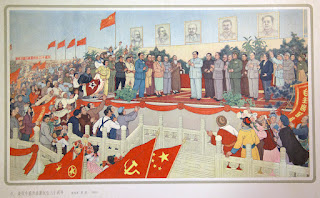Russia–The center of communism
This poster shows that Soviet Russia was the center of
communism. Russia’s centrality in the communist world also resonates in the
accounts of Dada Ameer Haider and Claude McKay, who belong to two different
parts of the world and ethnicities. I argue, that this is because Russia had
already experienced a successful communist revolution. It was also the first
revolution of its kind which inculcated confidence in the communists of the
world that they could also bring a change in their societies. In other words,
it was the first time the communist ideas of Marx were given a practical
reality. This is why revolution made them hopeful for a utopian future in their
respective nations and ethnicities. The portraits of Lenin and other Soviets at
the back tell us that the Chinese considered the Soviets as their leaders
because Mao’s portrait comes after Lenin and Stalin. Revolution also made the
Russian communists realize that now was the time to bring about change in other
parts of the world. This is why they sought to lead people from other parts of
the world in their way towards communism and they were very particular on this.
When McKay showed concerns over the possibility of a revolution in the near
future, one of them said: “you are a defeatist. The American Revolution cannot
be so far away”. Although considering the ongoing conditions of the working
class in the United States, McKay was reluctant to tell about the possibility
of the American Revolution. But the Russians were adamant about hearing that
the American Revolution was around the corner. This approach can be translated
as the unconditional firmness of the Russian people because they heard what
they wanted to hear, and ignored ground realities: “I must admit that the
Russians in those days were eager to be deceived”. I argue that it resulted in
the abandonment of the individual desire and thought only about the revolution
and gave way for a collective effort towards a single ideology–communism.
The visual of
collectivism is seen in the poster where Mao is the center and the public
around the turn towards him. They show no individuality and look at Mao as
their representative. He on their behalf turns towards Russia as evident by
the portraits behind him. Their slogan is for communism, as visible by the
flags, but the absence of individuality shows that it is about the propagation
of a singular ideology i.e. communism. The hammer and sickle are the highest
symbols on the portrait which shows communism as an idea transcending
boundaries. The presence of communist leaders in the portraits also paints a
picture of the idea of communism as a legitimizing factor for the working
class. Marx and Engels were the thinkers, and Lenin was the man behind
implementing the idea in Russia. This links to the poster because of the
confidence of the masses in Mao and his legitimacy as the leader premises on
the idea of a utopia which communism promises with the working class. They put
their trust not entirely on the person in the center but the portraits behind
him.

Comments